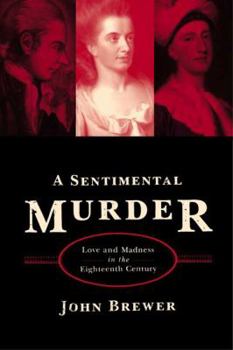A Sentimental Murder
Select Format
Select Condition 
Book Overview
One April evening in 1779, Martha Ray, the pretty mistress of a famous aristocrat, was shot dead at point-blank range by a young clergyman who then attempted to take his own life. Instead he was arrested, tried and hanged. In this fascinating new book, John Brewer, a leading historian of eighteenth-century England, asks what this peculiar little story was all about. Then as now, crimes of passion were not uncommon, and the story had the hallmarks...
Format:Paperback
Language:English
ISBN:0374529779
ISBN13:9780374529772
Release Date:June 2005
Publisher:Farrar, Strauss & Giroux-3pl
Length:352 Pages
Weight:1.00 lbs.
Dimensions:0.9" x 6.0" x 9.1"
Customer Reviews
2 ratings
Wonderful
Published by Thriftbooks.com User , 15 years ago
I have to admit, that I am not a scholar of history, but find this period to be absolutely fascinating. My view of Georgian England has been biased by exposure to accounts of courtly politeness and bodice ripping romance. While perhaps this is not the intent of this work, I feel that I have gained further insights into this period. This is a wonderfully written, fascinating look at history, and the effects of telling and retelling it. Anyone interested in this period of history would benefit from reading this book, the prose is excellent, execution is clear, and the story is engrossing.
A History of Histories
Published by Thriftbooks.com User , 20 years ago
This much is sure: James Hackman, a young clergyman, on 7 April 1779, outside of Covent Garden Theater in London, shot and killed Martha Ray, the mistress of the Earl of Sandwich, and then shot himself but failed to end his own life. What had gone on between the three figures before the murder was not clearly known, but this didn't stop speculations in the press at the time, and hacks, journalists, novelists, and historians have been having a go at the incident ever since. As John Brewer writes in _A Sentimental Murder: Love and Madness in the Eighteenth Century_ (Farrar, Straus, and Giroux), the unknown represented an empty space, and "Into the empty space rushed all sorts of speculation." Writers could wonder if the lovers were meeting secretly, were they having an affair, did they want to get married, was Ray willing or Hackman forceful, were they working together against Sandwich? Brewer's detailed and intriguing book does not answer the questions, but examines the answers that different writers and different societies have come up with to suit their own tastes and times. The murder of Martha Ray was legally an open and shut case, but its unknowns have kept it open to interpretation and to eager interpreters. The British press at the time made much of the murder, because of Sandwich's involvement. Remarkably, all three figures were written about with sympathy. Sandwich was depicted as a loving all-but-husband who had made a protected household for his mistress and the children she bore him. Ray may have been a mistress, but there was admiration for a woman who could have risen from low origins and become not a prostitute or even a courtesan, but a respectable companion and mother who was able to fill the household functions of a lady. Even the murderer emerged as a romantic hero. It was the age when sentiment and sensibility were highly prized. Hackman had a bad case of "love's madness," an out-of-control passion with which readers could sympathize rather than condemn outright. The first attempt to turn the case into a novel was not classed as a novel at all. _Love and Madness_ was published in 1780, and purported to be the actual letters between Ray and Hackman. It was written by Herbert Croft, a hack writer and would-be lexicographer who dedicated it to Samuel Johnson. Johnson told Boswell he did not like the book, as an example of a disagreeable mixture of fact and fiction, so he was not fooled by its claim to authenticity. Croft clumsily showed his hand by having Hackman lengthily discuss other literary forgeries that were current controversies, but he did amplify the view of Hackman as progressively maddened by his doomed love. Subsequent generations took up the tale, and "Victorian commentators worried over the story like a dog over a bone." In "Lyrical Ballads", William Wordsworth incorporated Martha Ray's name into the poem "The Thorn," its utterance symbolizing ambiguity. Physician Erasmus Darwin (grandfather of Charles) diagn





